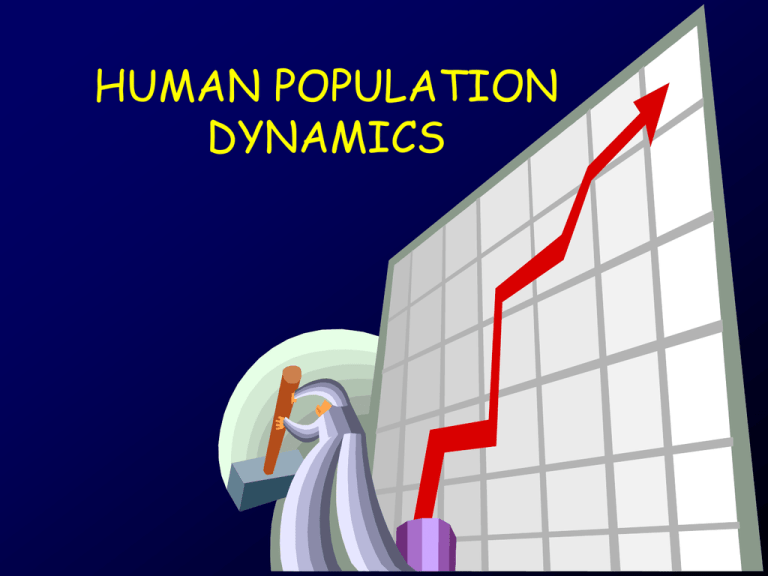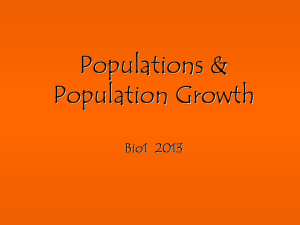
HUMAN POPULATION
DYNAMICS
See World Population Video
• What do you think?
Video
Did you Know?
06_12.JPG
How many people are on Earth?
Pop Census
• 6,788,977,211 (6.8 billion)
• How many people are in the U.S.?
– 308 million
• How much is 6.8 billion?
– See next slide for an exercise
How long would it take you to put
6.8 billion dots on a piece of paper?
• Take out a piece of paper and pen or pencil.
• Count the number of dots you can put on a piece
of paper in 5 seconds (have a partner time 5 sec).
• Calculate Dots/minute (x12), dots/hour (x60),
dots/day (x24), dots/year (x365).
– 6.8 billion dots divided by dots/year
POP
6800000000
DOTS/5s
26
YEARS
41.47
Note: 77 million
more people
added per year
you were
putting dots
How many people are on Earth?
• How much is one billion?
– How long is 7.8 billion seconds?
• 1 billion seconds is 31 years, 8.5
months!
• 6.8 billion = 215 years, 7.5 months!
History of Human Pop Growth
•
•
•
•
•
•
•
1804: 1 billion (took a looong time)
1927: 2 billion (took 123 years more)
1960: 3 billion (33 years)
1974: 4 billion (14 years)
1987: 5 billion (13 years)
1999: 6 billion (12 years)
????: 7 billion (? Years)
History of Human Pop Growth
Population Growth Rates
Future of Human Pop Growth?
06_06.JPG
Future
of
Human
Pop
Growth
?
Population Density
Average Annual Rate of Change
World Clock
Current Pop Growth Rate
•
•
•
•
•
•
•
•
•
•
•
10
9
8
7
6
5
4
3
2
1
0
In these 10 seconds…
41 people were born
• 18 people died
• = 23 people added to Earth
During this class… 39,244 born;
17,187 died; 22,058 people added
Current Pop Growth Rate
• 1.15% annual growth
– What does this mean?
– Use Rule of 70 to determine
Doubling Time
Type of Pop Growth
• Exponential Growth: J Curve
– Occurs when pop is growing at a
percent annual growth (versus some
fixed amount).
Power of exponential growth:
paper folding example
# Folds
Thickness
10
3.9 inches
20
30
40
50
332 feet
64 miles
65,943 miles
67.5 million miles
Using 0.0038” for paper thickness (20 lb test) =
263 sheets/inch.
Rule of 70 to determine
Doubling Time
• 70 divided by % Annual Growth =
Doubling Time (i.e., how long it takes
for the population to double)
Rule of 70: Example 1
• Example: 10% annual growth rate
• Current population is 1 million
• How long will it take to reach:
– 2 million?
• 70/10 = 7 years
– 8 million?
• 7 X 3 doubles = 21 years
Rule of 70: Example 2
• Example: 1.15% annual growth rate
• Answer: 70/1.2 = 61 years for
population to double in size
• So… in 61 years, at this rate, we will
have twice as many people on Earth!
Exponential Growth
What
should be
done?
http://dieoff.org/page80.htm
Exponential Growth
What
should be
done?
http://dieoff.org/page80.htm
Exponential Growth
What
should have
been done?
http://dieoff.org/page80.htm
Exponential Growth
What should wildlife
managers do?
Hunt them
Add predators
Move them
Do nothing (let them
starve)
Here’s another population
What did you
say we should
do?
Population (in billions)
7
6
5
4
3
2
1
0
1800
1850
1900
Year
1950
2000
Biotic Potential vs.
Environmental
Resistance
• One pair of cats adds up
to (assumes no deaths):
• First yr: 12
• Second yr: 66
• Third yr: 382
• Fourth yr: 2201
• Tenth yr: 80,399,780
Carrying Capacity
• MAXIMUM number of individuals an
area can support FOREVER.
• Law: Thou shalt not exceed the
carrying capacity, for long.
– As the caribou found out
Carrying Capacity
• What is the carrying capacity for
people on Earth?
Cultural Carrying Capacity
• Maximum number of individuals an
area can support forever AT A
GIVEN STANDARD OF LIVING.
What determines whether a
population size changes?
• Rate of Increase = (Birth Rate
+Immigration) – (Death Rate + Emigration)
• Age Structure = age and sex proportions in
a population
• Total Fertility Rate = average # of children
a woman has in her lifetime.
• Replacement Level Fertility Rate = average
# of children a couple must have to replace
themselves.
– 2.1 in MDCs and 2.5 in LDCs
AGE STRUCTURE
Fig. 4.8
TOTAL FERTILITY RATE
Factors affecting birth rates
•
•
•
•
•
•
Education
Affluence
Religious/cultural norms
Role of women in society
Infant mortality rates
Availability of birth control
What determines whether a
population size changes?
• Life Expectancy = how long an individual
is expected to live once they are born.
Table 4.3
What determines whether a
population size changes?
• Life Expectancy = how long an individual
is expected to live once they are born.
WHAT FACTORS DO YOU THINK
INFLUENCE LIFE EXPECTANCY?
Fig. 4.7
Human Population Growth and
the Environment
• Who has a greater impact on the
environment?
– Lesser Developed Countries??
– More Developed Countries??
Two Types of Overpopulation
• People Overpopulation
• Consumption Overpopulation
• Who has greater impact on the
environment – Lesser Developed
Countries with 80% of the people or
More Developed Countries using high
percentage of the resources?
Fig. 4.4
Population Growth Rates
06_04.JPG
06_16.JPG
Questions
• How does population growth affect
our world today?
• What will happen in the future if we
do not control population?
• What are the options for controlling
population? Pros and Cons:
– Volunteer vs Forced
• How should we control population?
If we could shrink the earth's population to a village
of precisely 100 people,
with all the existing human ratio's remaining the
same, there would be:
•
•
•
•
•
•
•
•
57 Asians
21 Europeans
14 from the Western Hemisphere, both N and S
8 Africans
52 would be female
48 would be male
70 would be nonwhite
30 would be white
If we could shrink the earth's population to a village
of precisely 100 people,
with all the existing human ratio's remaining the
same, there would be:
• 70 would be non-Christian
• 30 would be Christian
• 6 people would possess 59% of the entire world's
wealth and
• all 6 would be from the United States
If we could shrink the earth's population to a village
of precisely 100 people,
with all the existing human ratio's remaining the
same, there would be:
•
•
•
•
•
•
80 would live in substandard housing
70 would be unable to read
50 would suffer from malnutrition
1 would be near death; 1 would be near birth
1 (yes only one) would have a college education
1 would own a computer
• If you woke up this morning
with more health than
illness, you are more
fortunate than the million
who will not survive this
week.
If you have never experienced
the danger of battle,
the loneliness of imprisonment,
the agony of torture,
or the pangs of starvation,
you are ahead of 500 million
people in the world.
If you have food in the refrigerator,
clothes on your back,
a roof overhead
and a place to sleep,
you are richer than 70% of this world.
If you have money in the bank,
in your wallet, and spare
change in a dish someplace,
you are among the top 8% of
the world's wealthy.
If you can read this message,
you are more fortunate
than over two billion people in the world
that cannot read at all.
Did you Know?
THE FACTS ON CONSUMPTION
• Which world region consumes the most
energy per person?
•Average energy use per person is 9
times greater in more developed than
less developed regions.
•North Americans consume far more
energy than any other region.
THE FACTS ON CONSUMPTION
• Which world region consumes the most energy
per person?
In 2005, per capita energy use among
Americans was
•2x that of Europeans
•8x that of Developing Countries








